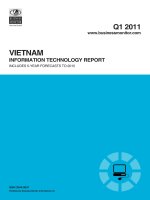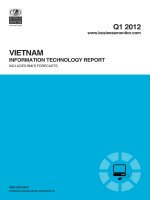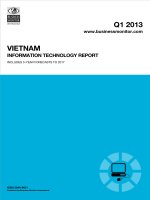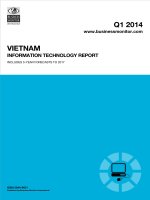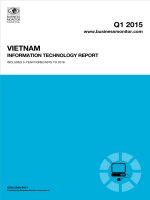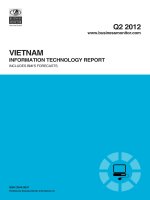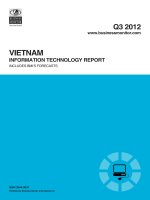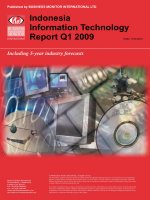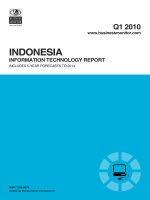Australia information technology report q1 2012
Bạn đang xem bản rút gọn của tài liệu. Xem và tải ngay bản đầy đủ của tài liệu tại đây (580.65 KB, 68 trang )
Q1 2012
Published by Business Monitor International Ltd.
www.businessmonitor.com
INFORMATION TECHNOLOGY REPORT
ISSN 2041-7160
Published by Business Monitor International Ltd.
AUSTRALIA
INCLUDES BMI'S FORECASTS
Business Monitor International
85 Queen Victoria Street
London
EC4V 4AB
UK
Tel: +44 (0) 20 7248 0468
Fax: +44 (0) 20 7248 0467
email:
web:
© 2012 Business Monitor International.
All rights reserved.
All information contained in this publication is
copyrighted in the name of Business Monitor
International, and as such no part of this publication
may be reproduced, repackaged, redistributed, resold in
whole or in any part, or used in any form or by any
means graphic, electronic or mechanical, including
photocopying, recording, taping, or by information
storage or retrieval, or by any other means, without the
express written consent of the publisher.
DISCLAIMER
All information contained in this publication has been researched and compiled from sources believed to be accurate and reliable at the time of
publishing. However, in view of the natural scope for human and/or mechanical error, either at source or during production, Business Monitor
International accepts no liability whatsoever for any loss or damage resulting from errors, inaccuracies or omissions affecting any part of the
publication. All information is provided without warranty, and Business Monitor International makes no representation of warranty of any kind as
to the accuracy or completeness of any information hereto contained.
AUSTRALIA INFORMATION
TECHNOLOGY REPORT
Q1 2012
INCLUDES 5-YEAR FORECASTS TO 2016
Part of BMI's Industry Report & Forecasts Series
Published by: Business Monitor International
Copy deadline: January 2012
Australia Information Technology Report Q1 2012
© Business Monitor International Ltd Page 2
Australia Information Technology Report Q1 2012
© Business Monitor International Ltd Page 3
CONTENTS
Executive Summary 5
SWOT Analysis 8
Australia IT Sector SWOT 8
Australia Political SWOT 9
Australia Economic SWOT 9
Australia Business Environment SWOT 10
IT Business Environment Ratings 11
Regional IT Business Environment Ratings 11
Asia IT Markets Overview 16
IT Penetration 16
IT Growth And Drivers 18
Market Overview 23
Government Authority 23
Background 23
Hardware 23
IT Services 28
Industry Developments 30
Table: Computers For Schools Programme, Phase Two – Planned Spending By State 32
Industry Forecast Scenario 33
Table: Australia's IT Sector – Historical Data & Forecasts (US$mn Unless Otherwise Stated) 35
Internet 36
Table: Telecoms Sector – Internet – Historical Data & Forecasts 36
Competitive Landscape 38
Computers 38
Software 40
IT Services 42
Table: Australia Dial-Up And Broadband Internet Subscriptions, 2009-2010 44
Table: Australian Broadband Market, June 2009-June 2010 47
ADSL2+ 48
Macroeconomic Forecast 55
Table: Australia – Economic Activity 57
Company Profiles 58
HP Australia 58
SAP (Australia) 59
Country Snapshot: Australia Demographic Data 61
Section 1: Population 61
Table: Demographic Indicators, 2005-2030 61
Table: Rural/Urban Breakdown, 2005-2012 62
Section 2: Education And Healthcare 62
Table: Education, 2002-2005 62
Table: Vital Statistics, 2005-2030 62
Section 3: Labour Market And Spending Power 63
Table: Employment Indicators, 2001-2006 63
Australia Information Technology Report Q1 2012
© Business Monitor International Ltd Page 4
Table: Consumer Expenditure, 2000-2012 (US$) 63
Table: Average Annual Wages, 2000-2012 64
BMI Methodology 65
How We Generate Our Industry Forecasts 65
Transport Industry 65
Sources 66
Australia Information Technology Report Q1 2012
© Business Monitor International Ltd Page 5
Executive Summary
Market Overview
In 2012, BMI forecasts Austalian IT market growth of 5%, with spending of US$21.8bn, compared with
US$20.8bn in 2011. Our forecasts for IT spending growth envisages a market value of US$27.0bn
expected by 2016, a 5% CAGR for the market.
New services such as cloud computing will pay a large part in the market's continued growth. The
government's six-year cloud computing strategy has been joined by a number of private and public sector
organisations launching their own initiatives.
Several factors underpin our forecast of a 5% 2012-2016 CAGR for the Australian IT market.
Government tenders will drive considerable spending in future. Banks will continue to need to spend on
regulatory compliance and intense competition in the retail sector is spurring spending on customer
relationship management (CRM) and back-office systems. Competition and new service platforms in the
telecoms sector are driving the key IT spending segment.
Industry Developments
The Australian federal government is implementing a six-year plan to transfer government agencies'
computing systems to a public cloud environment. According to the plan, public cloud adoption for
public-facing websites began in 2011, with pan-governmental integration scheduled to take place from
2012 onwards. However, the plan requires government agencies to notify the Department of Finance
Deregulation of their intention to move to the cloud.
Government projects in sectors such as e-government, healthcare, and education are driving significant
opportunities for IT vendors. The Australian government has announced plans for a standardised
reporting system scheme, while the National E-Health Transition Authority has set the goal of creating a
paperless environment in Australia's health sector, including public hospitals. Meanwhile, in Q411
education authorities in Queesland and New South Wales were rolling out IT initiatives.
In 2010, the Australian Senate passed a bill to restructure Telstra, to increase competition as Telstra's
infrastructure is incorporated in the new National Broadband Network (NBN). The NBN project aims to
connect 93% of the population by 2017 and aims to rectify a situation that has led to Australian
broadband charges being ranked the fifth most expensive among Organisation for Economic Cooperation
and Development (OECD) countries.
Company News
Telecoms service providers in the Australian market are investing in infrastructure to provide cloud
computing services. In Q111, telecoms company Telstra, in partnership with consulting leader
Accenture, launched a 45-day free trial of its cloud infrastructure for government agencies. Meanwhile,
Australia Information Technology Report Q1 2012
© Business Monitor International Ltd Page 6
rival telecoms company Optus already claims a number of high profile customers for its trial services,
including property company Savills and South Australia's Royal District Nursing Service (RDNS).
In H111, one of SAP's largest Australian partners, Oxygen, launched a new SAP Software-as-a-Service
(SaaS) offering that it called 'Oxygen on Demand'. The solution was touted as a total SAP cloud solution,
offering flexibility and speed-of-deployment. Many of SAP's Australian clients, including Fairfax
Media, Australia Post, CGU Insurance. and the Commonwealth Bank of Australia, already use cloud
computing to provide services.
HP has around a 20% share of the brand PC market, ahead of nearest rival Apple which, as a result of
sales of the iPad, has a share of around 15%. The top four vendors, including Acer and Dell, together
account for close to 60% of the market. The release of Apple's iPad created a new competitive
battleground, with Apple's rival vendors releasing their own products. However, Apple has so far
dominated tablet sales in the Australian market.
Computer Sales
Australian computer hardware sales are projected at US$9.5bn in 2012, with popularity of tablets helping
to keep demand buoyant in 2011 despite a moderation compared with 2010. Sales are forecast to grow at
a 2012-2016 CAGR of around 3% to reach US$10.5bn by 2016, with drivers including new products such
as tablets, as well as government programmes, and growing broadband penetration.
More than 90% of Australian households now have a PC and consumers appear willing to spend on
upgrading their notebook computers. It is also becoming more popular to purchase a second household
PC. Small businesses comprise more than 99% of all Australian businesses and slightly more than 50% of
business PC sales.
Software
Software is expected to account for about 17% of the Australian IT market in 2012, with estimated
spending of US$3.7bn. As the focus moves from hardware to services and solutions, the share of the
market accounted for by software is forecast to rise by 2016, with businesses seeking greater leverage
from their investments. Software sales are forecast to have a 2012-2016 CAGR of around 8%.
Given many businesses' focus on controlling costs, cloud computing models have also grown in
popularity and spread beyond initial core application areas. Over the forecast period, enterprise resource
planning (ERP), CRM and other e-business products will be increasingly popular with the small and
medium-sized enterprise (SME) market, as companies try to enhance productivity through automating
essential functions.
IT Services
IT services are expected to account for about 40% of the domestic IT market in 2012, with spending of
US$8.6bn, up from US$8.1bn in 2011. CAGR for the segment is estimated at 8% from 2012 to 2016.
Australia Information Technology Report Q1 2012
© Business Monitor International Ltd Page 7
In 2012, sectors such as government, telecoms, healthcare, and banking should continue to drive demand
for implementation, consulting and managed services. Regulatory compliance will continue to require
spending by banks, and intense competition in the retail sector is spurring spending on CRM and back-
office systems.
E-Readiness
Many alternative Australian internet service providers (ISPs) are in the process of expanding the coverage
of their ADSL networks. Other broadband service providers, including Unwired, are rolling out WiMAX
networks, which will ensure greater choice and flexibility in the type of broadband connection available.
Australia is above the OECD average in terms of businesses purchasing online (49% compared to 33%)
and selling online (27% compare to 17%).
The central component of the government's ICT strategy and overall domestic economic policy is the
construction of a National Broadband Network. The programme is expected to drive economic growth
and foster the creation of a digital economy. The government has projected GDP gains of 1.4% after five
years from the broadband project.
Despite these investment commitments, our outlook for Australian broadband growth continues to be
cautious. This is based partly on delays that have characterised government and operator efforts to
address the problem of low broadband coverage in rural parts of Australia. Meanwhile, fixed penetration
rates in urban areas are already high.
Australia Information Technology Report Q1 2012
© Business Monitor International Ltd Page 8
SWOT Analysis
Australia IT Sector SWOT
Strengths
Strong government support for ICT programmes.
IT-literate population.
Strong financial sector.
Relatively unaffected by global economic crisis compared with Europe and the US.
Weaknesses
Australia has a relatively mature domestic market, with relatively slow growth rates.
Sensitive to volatility in the global economy.
Opportunities
The National Broadband Network programme will have many direct and indirect
benefits for the IT market.
Phase two of the computers for schools project is expected to generate an additional
US$800mn of spending.
Other major IT projects in areas such as healthcare and smart cards.
Green IT as companies look to make power savings.
Threats
The biggest threat is the global economic slowdown affecting Australia's economic
activity and leading to a scaling back of IT budgets.
The cheaper Australian dollar will affect consumer and business demand in the
import-dependent IT market.
Australia Information Technology Report Q1 2012
© Business Monitor International Ltd Page 9
Australia Political SWOT
Strengths
Australia is a mature democracy with a broadly stable party system.
Economic stability over recent years supports the current political system and radical
groups are unlikely to gain substantial support.
Weaknesses
As one of the region's largest and most stable states, the country attracts many
refugees and economic migrants. The issue is a key source of domestic tension and
one that is unlikely to disappear over the medium term.
Opportunities
Australia has historically enjoyed close military ties with the US. However, with the rise
of regional economic powers such as China, it will need to balance competing military
and economic ties.
Threats
Australia's early support for the US 'War on Terror', among other things, has made
Australians abroad a target for Islamic extremists.
Australia's close alliance with the US, particularly under John Howard, has left a
lingering feeling among some Asian governments that Canberra is Washington's
'deputy sheriff' in the region.
Australia Economic SWOT
Strengths
A free-market economy supported by a highly educated workforce.
Blessed with rich natural resources, Australia's economic activity will be augmented by
commodity exports, especially to China.
Weaknesses
The persistent current account deficit increases vulnerability to capital flows and, by
extension, currency volatility.
The export basket is highly concentrated in commodities, with the consequence that
the economy and currency remain vulnerable to fluctuations in world prices for metals,
coal and agricultural goods.
Opportunities
The rapid expansion of Asian economies in recent years – notwithstanding the current
global recession – offers new opportunities for diversifying trading ties from core
European markets.
A low level of government debt has provided a certain amount of flexibility in fiscal
policy to support domestic demand through the downturn.
Threats
The high level of private sector debt – especially mortgage loans – poses a threat to
sustained growth.
A collapse in exports from a drop in resource demand from China would severely
impact headline GDP growth.
Australia is vulnerable to extreme weather that may lead to droughts and floods, which
have become increasingly severe in past years as a result of global climate change.
Australia Information Technology Report Q1 2012
© Business Monitor International Ltd Page 10
Australia Business Environment SWOT
Strengths
A highly educated workforce and comparatively modern transport infrastructure
underpin economic prospects.
A number of free trade agreements with countries such as New Zealand, Thailand and
the US serve as a boon for trading activities.
Weaknesses
Despite its openness, Australia requires the Foreign Investment Review Board to
approve any commercial real estate investment by a foreign company or individual
valued at US$5mn or more.
With a population of just over 22mn, the domestic consumer base is small by regional
standards.
Opportunities
Australia is currently in talks with China, Malaysia, the Gulf Co-operation Council,
Japan and South Korea regarding potential bilateral free trade agreements and it is
also considering similar agreements with India.
Upgrade and expansion of urban infrastructure will be needed to sustain population
growth in Australia's main cities, providing opportunities for public-private partnerships
in the future.
Threats
Corporate taxes for foreign investors in Australia remain higher than in other states,
even as the government has promised to gradually reduce rates over the medium
term.
Recent investment proposals by Chinese firms regarding the resource extraction
sector have raised fears that strategic assets will be lost to foreign players.
Australia Information Technology Report Q1 2012
© Business Monitor International Ltd Page 11
IT Business Environment Ratings
Regional IT Business Environment Ratings
Limits Of Potential Returns
Risks To Realisation Of
Returns
IT
Market
Country
Structur
e
Limits
Market
Risks
Country
Risk
Risks
IT BE
Rating
Regiona
l
Ranking
Australia 56
100
71
80
71
75
72.2
1
Singapore 53
100
69
70
85
79
72.1
2
Hong Kong 48
95
65
70
87
80
69.4
3
South Korea 52
75
60
75
71
73
63.9
4
Malaysia 41
50
44
35
77
60
49.1
5
China 52
35
46
35
68
55
48.7
6
Vietnam 36
60
44
35
45
41
43.2
7
Philippines 37
45
40
43
52
48
42.2
8
India 49
15
37
45
56
51
41.4
9
Thailand 40
20
33
35
73
58
40.4
10
Indonesia 38
35
37
35
52
45
39.1
11
Sri Lanka 30
10
23
35
44
41
28.3
12
Scores out of 100, with 100 highest. The IT BE Rating is the principal rating. It comprises two sub-ratings, 'Limits Of
Potential Returns' and 'Risks To Realisation Of Returns', which have a 70% and 30% weighting respectively. In turn,
the 'Limits' rating comprises Market and Country Structure, which have a 70% and 30% weighting respectively and are
based upon growth/size/maturity/govt policy of IT industry (Market) and the broader economic/socio-demographic
environment (Country). The 'Risks' rating comprises Market Risks and Country Risk, which have a 40% and 60%
weighting respectively and are based on a subjective evaluation of industry regulatory and IP regulations (Market) and
the industry's broader Country Risk exposure (Country), which is based on BMI's proprietary Country Risk ratings. The
ratings structure is aligned across the 14 industries for which BMI provides Business Environment Ratings
methodology and is designed to enable clients to consider each rating individually or as a composite, depending on
their exposure to the industry in each particular state. For a list of the data/indicators used, please consult the
appendix at the back of the report. Source: BMI
BMI's Asia IT Business Environment Ratings (BER) compare the potential of a selection of the region's
markets over our forecast period through to 2016. Our Q112 ratings reflect our consideration of political
and economic risks, as well as risks associated specifically with IT intellectual property (IP) rights
protection and the implementation of state spending projects.
Australia therefore retains its top regional rating in Q112. The market is expected to remain in positive
growth territory, despite business concerns about the domestic carbon tax and the global economic
situation. One leading area of opportunity is growing demand for cloud computing services. A wide range
Australia Information Technology Report Q1 2012
© Business Monitor International Ltd Page 12
of leading Australian private and public sector organisations, including many of the country's leading
banks, have launched cloud initiatives. Meanwhile, the government has unveiled a six-year cloud
computing strategy.
Australian IT verticals such as government, telecoms, healthcare and banking should continue to supply
demand for implementation, consulting and managed services in future. The government's commitment to
continue to implement the National Broadband Network project will drive the development of Australia's
digital economy and feed demand for PCs.
The smaller, but mature IT markets of Singapore and Hong Kong take second and third positions
respectively in our ratings table, due primarily to their high Country Structure scores. Hong Kong and
Singapore are expected to emerge as cloud computing hubs due to growing interest in cloud computing
across the region.
We forecast solid IT market growth in these markets in 2012. However, this will depend on continued
business and consumer confidence in the economic recovery, which could feel an impact if China
experiences a slowdown. Key sectors of the Hong Kong economy such as financial services are investing
in modernisation as Hong Kong strives to maintain its regional hub status in the face of competition from
rivals such as Shanghai. Hong Kong also continues to offer IT investors opportunities associated with its
growing links to the vast Chinese market.
Meanwhile, Singapore's ambitions to emerge as a regional cloud computing hub will fuel vendor
investment in service capabilities. Moreover, ambitious projects such as the national healthcare register
and the schools standard operating environment will bolster the IT market. Singapore benefits from high
broadband penetration and initiatives such as the government's ambitious Intelligent Nation 2015 plan.
Singaporean spending on IT services will be boosted by the continuing boom in IT-enabled services such
as call centres and back-office financial services. Other promising sectors for IT services include
healthcare, as the government launches a series of initiatives to develop health technology.
On the downside, the continued restructuring of both economies, towards a more service-oriented model,
may limit long-term growth prospects. However, this also brings opportunities in sectors such as financial
services and banking. Businesses will probably remain cautious and value focused over the short term.
BMI forecasts that South Koreans will increasingly choose to spend money on IT products due to a
substantial increase in disposable incomes. Consumers appear willing to upgrade their PCs, and there is
also a trend for households to own more than one computer.
Meanwhile, South Korea's government is encouraging the utilisation of cloud computing by small
businesses. New cloud computing offerings and increased competition in this segment are expected to
Australia Information Technology Report Q1 2012
© Business Monitor International Ltd Page 13
fuel growing demand for this technology. IT outsourcing is also expected to show a strong demand
trajectory.
Malaysia remains in fifth position in our Q112 regional ratings. Demand is expected to stay resilient, even
as economic growth moderates. Government spending may become more constrained, because of
commitments to tackle the budget deficit, but there will be growth areas. IT spending growth will be
driven by the government's drive for greater broadband penetration. It has set an optimistic target of 75%
by 2015.
The roll-out of a Malaysian high-speed broadband network will boost IT spending outside the Klang
Valley. Other projected growth and PC market drivers include a rise in the PC penetration level from
about 35%, tax exemptions for notebooks and growth in disposable incomes.
There are increasingly attractive opportunities in the IT services area as the government implements
measures to make Malaysia a growing regional services and outsourcing hub. Cloud computing will also
be a growth area and the government has named cloud computing as one of its top 10 strategic technology
priorities.
In China, despite an expected moderation in investment and retail spending over the next year, an
expansion in consumer credit will help drive IT market growth. The rural electronics subsidy programme
will continue to boost demand from the vast, underpenetrated rural areas. The lower tier cities and towns
are expected to be the fastest growing segment of the PC market but pressure on hardware prices is also a
risk in the current environment.
Factors such as the vast potential rural market and a commitment to modernisation in sectors such as
education, healthcare and manufacturing are among other expected drivers. In the Chinese IT services
segment, growing interest in cloud computing will be stimulated by the establishment of government pilot
programmes in five cities. However, there are still market risks associated with IP rights protection in
China, as well as piracy and a lack of business transparency.
Vietnamese IT demand, although with a rather smaller market than its leading neighbour to the north, is
expected to have several long-term drivers. Vietnam's improving ICT infrastructure will facilitate the
development of the nation's IT market in a country with just 15% PC penetration. PC subsidy
programmes will support the PC market in 2012 as the government continues to roll out the One Teacher-
One Computer programme.
Vietnamese government digital divide programmes to boost internet and digital utility in rural areas will
help addressable market growth and open PC ownership to a growing number of rural inhabitants.
Vietnam's gradual integration into global trade networks such as ASEAN and the WTO has helped reduce
tariff barriers and prices, and has increased opportunities.
Australia Information Technology Report Q1 2012
© Business Monitor International Ltd Page 14
In the Philippines, the IT market will be driven by the local IT and business process outsourcing (BPO)
sector. The BPO industry, which accounts for around 30% of IT spending, continues to grow. The
Philippines has a lower PC penetration than many other Asian countries and the IT market offers
corresponding high growth potential over the forecast period.
However, the Philippines faces challenges such as labour shortages and rising wages. In the enterprise
segment, surveys suggest that many businesses including small and medium-sized enterprises (SMEs)
plan to increase IT spending.
India's IT market appears set to continue a strong recovery in 2012 thanks to a growing economy and
healthy consumer sentiment The potential is clear, with less than 2% of the population owning a
computer, which is about 20% of the level in China. It is estimated that around 400,000 Indian SMEs
implement an IT solution annually Significant opportunities will be created by demand from Indian
businesses and government agencies to help utilise cloud computing.
There are expected to be strong growth opportunities in the next 200-400 smaller cities in India, where
vendors are expanding their retail and distribution presence. Realisation of India's growth potential
depends on fundamental drivers such as increasing India's low computer penetration, rising incomes,
falling computer prices and the government's ambitions to connect the country's vast rural areas to the rest
of the world.
The last three markets in our regional ratings have low scores due primarily to business environment
factors, despite considerable growth potential. In Thailand, the fundamentals of growing affordability and
low PC penetration should keep the market in positive territory during the forecast period. The PC market
received a severe impact from the recent floods, and this is expected to continue into H112, with forecasts
for Q112 PC sales downwardly revised by around 10% in Q112. A number of factors should also support
momentum, including the government's PC for Education programme and 3G mobile and WiMAX
broadband service rollouts. BMI's view is that the fundamentals of growing affordability and low PC
penetration will keep the market on a positive growth trajectory.
Similarly, with PC penetration at only around 6%, and development restricted to richer areas such as Java,
the Indonesian IT market has much growth potential. BMI expects the Indonesian market to be one of the
fastest growing in the region over the five-year forecast period. Government infrastructure investments
should also provide a boost to Business IT investment, which will likely remain buoyant in line with the
general economy as inflation moderates. Spending in key IT verticals, such as financial services and
banking should continue to be significant. The SME sector will drive demand for basic hardware and
applications as enterprises focus on enhanced productivity.
Sri Lanka's IT market has benefited from the restoration of peace and improvements in the security
situation, which helped release pent-up demand for IT solutions. The country has felt the effects of
instability over the years, from disruption of distribution channels and a flourishing grey market to the
Australia Information Technology Report Q1 2012
© Business Monitor International Ltd Page 15
underdeveloped telecoms infrastructure. However, Sri Lanka will feature on IT vendors' radars as one of
the best potential growth prospects in South Asia. Computerisation has only started in government
services and major public and private sector organisations remain largely underpenetrated in terms of
basic enterprise software.
Australia Information Technology Report Q1 2012
© Business Monitor International Ltd Page 16
Asia IT Markets Overview
IT Penetration
Across Asia, government ICT initiatives and
growing affordability will help to drive increases
in PC penetration during BMI's five-year forecast
period. While some cities and regions stand out,
there is an unbalanced pattern of regional
development, with PC penetration in countries
such as Singapore above 50%, while in other
countries, such as Indonesia, it is below 5%.
The two Asian leaders, China and India, embody
the region's growth potential, as in both countries
computer ownership remains the preserve of a
minority. In China, PC penetration was only
around 25% in 2010 – although it was far higher in cities such as Shanghai and Beijing and urban PC
penetration is projected to pass 60% by 2015. In India, less than 5% of people own a computer. However,
some 45% of the population is under 25, which provides a promising demographic context for increased
PC ownership. PC penetration in Vietnam was estimated by BMI at around 15% in 2010. Notebooks are
owned by an estimated 7% of the Vietnamese population, which points to significant growth potential for
the local PC market.
Lower prices will help to drive higher PC
penetration in developing markets. The average
price of a PC in the Indian market has nearly
halved over the past few years, and rising incomes
and greater credit availability will continue to
bring computers within the reach of lower-income
demographics. Even in more mature markets, there
is room for development, however, with official
data suggesting that as many as 25% of Hong
Kong households do not have a computer at home.
Around the region, affordable computer
programmes continue to find favour with
governments. In China, a subsidised household electronics products initiative aimed at rural residents has
helped to boost PC sales in areas where penetration was low. In Australia in 2010, national and state
Narrowband Penetration
Per 100 Population
e/f = estimate/forecast. Source: BMI
Broadband Penetration
Per 100 Population
e/f = estimate/forecast. Source: BMI
Australia Information Technology Report Q1 2012
© Business Monitor International Ltd Page 17
governments continued to roll out new initiatives, with the Victoria government investing more than
US$150mn in IT in schools.
In Indonesia, PC penetration of around 2% could double by 2013 if government initiatives are followed
through. The Indonesian government is also rolling out new e-learning initiatives, with a target of raising
the current 1:3,200 ratio of PCs to students in public schools to 1:20. Meanwhile, in 2010, the Vietnamese
government launched a programme entitled One Teacher-One Computer, which offered discounts on PCs
for teachers and students.
A similarly broad range is found with respect to internet penetration. The highest levels of internet
penetration are found in Singapore, South Korea, Hong Kong and Australia, with estimated 2011
penetration rates of 78.5%, 76.4% and 75.5% and 67.4% respectively. Singapore has by far the highest
rate of broadband penetration, which was estimated at 160.2% in 2011. Meanwhile, the Philippines has
the one of lowest levels of internet usage, with just 7.1% narrowband and 6.1% broadband penetration
estimated in 2011.
The fastest growth is expected in Indonesia, where internet penetration is projected to leap from 36% in
2011 to 67.4% by 2015. India is now at above 28% internet penetration despite a lack of fixed-line
infrastructure, and this should reach 36% by 2015. Steady growth is also projected for Sri Lanka, where
penetration is projected to increase from 14.1% to 19.4% by 2015. Some 60.4% of Malaysians had
internet access in 2010.
Dial-up technology is still the dominant access method in many states. However, even in developing
markets, the number of broadband subscribers continues to gain ground steadily. Broadband penetration
has been boosted by growing numbers of mobile broadband users, as 3G mobile services are expanded
across the region. In China, broadband penetration is on course to reach 33.1% by 2015. In India,
penetration should increase sixfold to reach 9.4% by 2015 from around 1.5% currently, although this
remains below government targets. Singapore will also see continued strong growth in broadband
penetration, which is projected to reach 186% by 2015.
Across the region, government programmes are an important driver of ICT penetration. The Chinese
government has a five-year plan to make the internet available in every administrative village in central
and eastern China and every township in the west. In Australia, the government's commitment to develop
the National Broadband Network should further the development of Australia's digital economy.
Meanwhile, the growth of Wi-Fi coverage will be one driver of notebook sales in places such as Hong
Kong, where the government has committed another HKD200mn to the deployment of a Wi-Fi network
covering more than 200 public venues.
Australia Information Technology Report Q1 2012
© Business Monitor International Ltd Page 18
IT Growth And Drivers
Across the region in 2011, IT spending should
benefit from improved economic circumstances
and tenders, previously deferred as a result of the
economic situation, although much will depend on
business confidence. Strong fundamental demand
drivers of IT spending mean that there will be
continued opportunities. Key factors common to
most markets include cheaper PCs and reform in
sectors such as telecommunications and finance,
as well as government initiatives.
In some of the region's largest markets, such as
China, lower-tier cities and towns will be among
the fastest growing segment of the IT market. BMI expects China's IT market growth to be driven by an
expansion into western China and rural areas well as growing demand from small and medium-sized
enterprises (SMEs). The Chinese IT market will also receive a boost in 2011 from a 50% increase in
import tariffs on some electronics products,
such as laptops.
In Thailand in 2011, demand will be bolstered
by market expansion in the relatively
underpenetrated rural areas. SIS forecasts that
market growth in upcountry areas will be 30%
in 2011, double that forecast for the country as
a whole. A similar situation pertains to India
where in 2011 there are expected to be strong
growth opportunities in smaller cities.
The long-term potential of India's IT market is
plain: less than 3% of people in India own a
computer (about one-fifth of the level in
China), meaning particular potential in the lower-end product range. India's IT market appears to be
positioned for strong growth thanks to an improving economy and consumer sentiment, and government
support for modernisation in lagging sectors. Meanwhile, India's business process outsourcing industry is
growing at around 40% per annum and will continue to generate opportunities for vendors of IT products
and services.
2011e IT Market Sizes
US$mn
e = estimate. Source: BMI
IT Market Sizes
As % Of National GDPs
e/f = estimate
/
forecast. Source: BMI
Australia Information Technology Report Q1 2012
© Business Monitor International Ltd Page 19
The Philippines is one of the countries
currently benefiting from low-priced PC
programmes (PC4ALL), which provide
opportunities for vendors to penetrate the low-
income segments. Other regional computer sale
drivers over the forecast period include
education, lower prices, IP telephony, cheaper
processors as well as notebook entertainment
and wireless networking features. Meanwhile,
in Indonesia, the basic demographics of rising
computer penetration and growing affordability
should drive growth. SMEs represent a growth
opportunity, as currently only around 20% of
Indonesian SMEs are estimated to make use of IT. Compliance with government and international
regulations will be a driver in financial, manufacturing and other sectors.
In more developed markets, such as Hong Kong and Singapore, robust retail sales led the way in early
2010 as spending recorded positive growth following a contraction in 2009. In Hong Kong consumer
spending is expected to remain strong in 2010, as evidenced by the positive early reception for Apple's
iPad. IT market growth will be driven by government IT spending as well as cross-border trade and
cooperation.
The largest IT market in the region is, unsurprisingly, China, estimated at US$105.4bn in 2011, trailed
distantly by Australia (US$20.8bn), India (US$19.7bn) and South Korea (US$17.8bn.) Singapore's IT
market (including communications) is the largest as a proportion of national GDP (2.2%), followed by
Hong Kong (2.1%). Thailand's IT market was affected last year by a number of exogenous events
including floods in the north east of the country, and political unrest. However, in 2011 the country looks
to be back on track.
The fastest growing IT markets over the forecast period are projected to be India and Indonesia with
2011-2015 compound growth of 109% and 91% respectively, driven by increasing PC penetration. Sri
Lanka is third with the IT market growing by an estimated 89% over BMI's five-year forecast period,
while China's total growth is estimated at a still healthy 70%.
Sectors And Verticals
Regional IT markets remain hardware-centric, with hardware accounting for 25-74% of total spending in
all markets in 2010. However, spending on software and services will grow faster. Notebook sales are
growing much faster than the PC market as a whole with growth driven by falling prices and more
features.
IT Markets Compound Growth
2011e-2015f (%)
e/f = estimate/forecast. Source: BMI
Australia Information Technology Report Q1 2012
© Business Monitor International Ltd Page 20
In mature markets such as Australia and Singapore, PC sales are dominated by replacement sales. In
Australia, upgrades are estimated to account for at least 80% of business purchases and more than 50% in
the case of households. More than 90% of Australian households now have a PC, but consumers have
appeared willing to spend on upgrading their notebook computers and it is also becoming more popular to
purchase a second household PC. Indeed, around 30% of households have more than one PC.
Tablet sales will lead to a new PC market growth area, with triple-digit growth projected in many
markets. In China it is estimated that tablets could account for around 6-7% of computer sales in 2011.
However, partly thanks to the tablets surge, demand for netbooks has lost momentum in some markets.
Sales, although initially promising, have sometimes fallen short of perhaps unrealistic expectations. In
Australia, netbooks sales growth slowed from the first quarter of 2010, and this has continued into 2011.
In less developed markets, demand from under-penetrated rural areas, affordable computer programmes
and growing broadband penetration should generally drive growth. In China, as in much of emerging
Asia, demand from smaller towns and rural areas where PC penetration is relatively low will provide the
main source of growth. Another driver will be replacement of desktops with notebooks. SMEs will be one
of the strong growth segments over the forecast period, with SME demand for servers and networking
equipment a significant growth opportunity.
Falling prices is another major driver, placing pressure on margins. As of the third quarter of 2010, the
average price of a PC in China was estimated to have fallen to around US$600, considerably below the
price level in developed markets. In India, the average price of a PC has nearly halved over the past few
years, and rising incomes and greater credit availability will continue to bring computers within the reach
of lower income demographics.
In both emerging and more mature markets, the growing popularity of broadband will help to support
computer sales. China Telecom is among regional telecoms companies to have rolled out PC bundling
offers as part of its broadband packages. Meanwhile, broadband plans will also help to popularise tablets.
At the end of 2010, Australian telecoms operators such as Telstra were competing to offer affordable
tablets bundled with data services.
Meanwhile, a wave of 3G launches across the region should also provide a stimulus to sales of notebooks,
with Vodafone Hong Kong among service providers offering 3G/HSPA USB modems bundled with
their 3G services. However, netbooks and notebooks face competition from other form factors such as
smartphones from Palm, RIM, Apple and other vendors, and tablet notebooks, spearheaded by Apple's
iPad,
Due in part to high levels of piracy, software's share of IT spending is relatively low, ranging from 9-25%
among countries covered by BMI. Efforts are being made to tackle the issue of piracy, but despite
government crackdowns in China and the Philippines, software piracy remains above 70% in most of
emerging Asia.
Australia Information Technology Report Q1 2012
© Business Monitor International Ltd Page 21
In 2011, sales of Microsoft's Windows 7 operating system and new Intel core technology retain the
potential to help trigger hardware upgrades, although much will depend on business confidence.
Hundreds of large enterprises and thousands of small enterprises in China have already started migrating
to Windows 7, and this process is expected to continue in 2011.
Across the region there is a growing trend for smaller companies to seek greater efficiency by using IT to
improve productivity and reduce costs (including labour costs). As Asian companies have become more
integrated into the global supply chain, their multinational business partners often encourage them to
install backoffice systems to meet efficiency requirements.
In general, enterprise resource planning (ERP) and other e-business products still dominate the enterprise
software market, but vendors are also looking to other areas such as customer relationship management
(CRM) and business intelligence, where faster growth is possible. Although the market remains relatively
small, more companies are looking at computing solutions such as Software-as-a-Service (SaaS). Cloud
computing business models such as SaaS offer smaller businesses a cost-effective way to deliver
applications such as payroll, tax-return processing and recruitment.
The hosted application model may already account for between one-fifth and one-quarter of Chinese
software revenues and SaaS has also enjoyed steady growth in the Hong Kong market over the past few
years. Improved broadband infrastructure will assist the popularisation of the rented software model in
markets such as Indonesia. Meanwhile, around one-third of Australian organisations already use some
cloud computing.
New platforms and services in the telecoms field is a driver for that key IT spending segment, where an
industry restructuring with the advent of 3G mobile services has led to more competition. Meanwhile,
expanding technology adoption in the logistics industry and public transport will be a source of IT
services projects. Sectors such as hospitals and real estate will also provide opportunities.
The IT services segment accounts for 17-40% of spending in the Asian markets covered by BMI. The
global economic slowdown and credit tightening had an impact on projects in some verticals, but in 2010,
a brightening business climate should mean more opportunities in key IT-spending verticals such as
Financial Services, Telecoms, Government, Healthcare and Logistics.
Government spending will account for a larger share of spending in many markets. In China, government
stimulus packages have helped to drive IT-related investments, while in Singapore government ICT
projects such as SOE2 provide significant opportunities. Meanwhile, the Hong Kong government's
Digital 21 initiative will continue to generate spending.
Regionally, hardware deployment services remain the largest IT services category, with other
fundamental services including system integration, support systems, training, professional services,
outsourcing and internet services. Main spenders across the region include banks and financial institutions
Australia Information Technology Report Q1 2012
© Business Monitor International Ltd Page 22
as well as governments. Even in emerging markets such as India, IT vendors are having to pay more
attention to value-added services such as technical support and product troubleshooting, or basic IT and
hardware consulting.
In many countries, the number and size of local outsourcing deals are increasing. Outsourcing could
account for as much as 30% of China's IT services spending by 2013, while in India there have been some
large contracts such as that awarded by Idea Cellular to IBM. Singapore and Hong Kong have both seen
a trend towards larger outsourcing projects in the public and private sectors.
Market Structure (% Of Total IT Mark
et)
2011e
2015f
e/f = estimate/forecast. Source: BMI
Australia Information Technology Report Q1 2012
© Business Monitor International Ltd Page 23
Market Overview
Government Authority
Government Authority Department for Broadband, Communications and the Digital Economy
Chairman Stephen Conroy
The Department for Broadband, Communications and the Digital Economy was established in 2007 after
the election of the Rudd government and was a successor to the former Department of Communications,
Information Technology and the Arts. The main policy responsibilities of the ministry include:
Broadband policy and programmes;
Postal and telecommunications policies and programmes;
Spectrum policy management;
Broadcasting policy;
National policy issues relating to the digital economy and;
Content policy relating to the information economy.
Background
Australia's IT market is based on imports, with a relatively small local IT sector. Multinational brands
such as HP, IBM, SAP, Dell, and Acer dominate the market and most have a substantial presence.
The local IT sector is mainly made up of small companies involved in software development and ICT
manufacturing with military applications. The sector employs around 270,000 people, with more than
95% of firms employing fewer than 20 workers.
Hardware
Australian computer hardware sales are projected at US$9.5bn in 2012, with the popularity of tablets
keeping demand buoyant in 2011 despite a moderation compared with 2010. Sales are forecast to grow at
a 2012-2016 CAGR of around 3% to reach US$10.5bn by 2016, with drivers including new products such
as tablets, as well as government programmes and growing broadband penetration. The fastest-growing
segment is notebooks, which already accounts for more than 60% of the market by value.
In 2011, the PC market was on course to remain in single-digit growth, overcoming various adverse
factors. Business demand was affected by concerns about the economic situation in Europe and the US, as
Australia Information Technology Report Q1 2012
© Business Monitor International Ltd Page 24
well as domestic issues such as the proposed carbon tax. Meanwhile, a shortage in the supply of AMD
processors was also a drag on the market in H211. Despite this, aggressive promotions and discounting by
retailers such as Harvey Norman with its 2-for-1 offer, as well as sales of tablets, helped to sustain the
market. In Q412, a shortage of hard disk drives resulting from the flooding in Thailand was forecast to hit
Christmas sales.
Government programmes are another factor helping to keep computer hardware demand in positive
growth territory. Firstly, government subsidies of computers in education will provide support for the
market. National and state governments have continued to roll out new initiatives, with the Victoria
government investing more than US$150mn in IT in schools. In Q411, large education programmes were
launched in Queensland and New South Wales, although the Thailand floods were expected to mean
some delays in supplies.
The second phase of the national government's computers for schools programme was expected to
provide 141,600 new computers to schools around the country, with the value of the programme
estimated to have already reached around AUD260mn by the end of 2009. In July 2008, the
government had passed a measure allowing households to reclaim a 50% rebate of up to US$625 a year
for primary and US$1,500 for secondary students for laptops and other IT-related equipment.
Secondly, the government's ambitious broadband plans will also drive expansion. The government's
National Broadband Network plan should further the development of Australia's digital economy and
services such as online banking and shopping. Converged multimedia services such as internet protocol
television (IPTV) will also feed demand for PCs and notebooks with entertainment features. Bundling
deals by 3G mobile telecoms service providers such as Vodafone will help drive sales of portable
computers as connectivity devices.
Single-digit growth in PC shipments is forecast in 2012, as the market is affected by weaker consumer
confidence. The main driver has been consumer notebooks, with total notebook sales forecast of 3.3mn
units in 2011, after sales achieved annualised growth of one-third in 2010. Meanwhile, business sales
received a boost from computer hardware tenders previously delayed because of the economic
situation. Migrations to Microsoft's Windows 7 operating system have fuelled hardware upgrades and
should continue to do so, although much will depend on confidence.
Overall, hardware spending accounted for around 45% of the domestic IT market in 2011, although this
share is set to decline. Unsurprisingly, given the high penetration levels in business and consumer
segments, the Australian PC market is dominated by replacement sales. Upgrades are estimated to
account for at least 80% of business purchases and more than 50% in the case of households. BMI
expects a trend of rising investment to establish itself over the next few quarters.
PC penetration is high among businesses, with around 95% of small businesses and 100% of medium-
sized and large businesses having computers. Small business comprises more than 99% of all Australian
